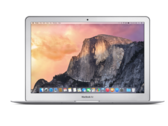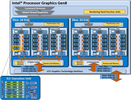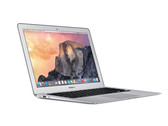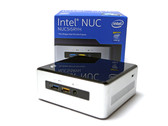
Recensione breve del Portatile Apple MacBook Air 13 2017 Laptop (1.8 GHz)
Intel Core i5-5350U | Intel HD Graphics 6000 | 13.30" | 1.4 kg

L'Intel HD Graphics 6000 (GT3) Þ una scheda grafica Broadwell integrata presentata ad inizio 2015. Si trova in molti SoCs low-voltage (15 W TDP) come il Core i5-5250U o l'i7-5650U. La cosiddetta GPU GT3 offre 48 EUs (execution Units) e quindi un po' di potenza shader in pi¨ rispetto alla precedente HD 5000 (40 EUs). In base alla specifica CPU, la frequenza massima GPU varia tra 950 e 1000 MHz.
Architettura e Features
Il Broadwell sfrutta una GPU basata sull'architettura Intel Gen8, che Þ stata ottimizzata in vari aspetti rispetto alla precedente Gen7.5 (Haswell). Tra l'altro, gli shader arrays chiamati "subslice" sono stati riorganizzati ed ora offrono 8 Execution Units (EUs) ciascuno. Tre subslices formano una "slice" per un totale di 24 EUs. Unitamente con altri miglioramenti come caches L1 maggiore e frontend ottimizzato, la GPU integrata Þ diventata pi¨ veloce e pi¨ efficiente rispetto al suo predecessore.
L'HD Graphics 6000 rappresenta la versione top-end della famiglia di GPU Broadwell e consiste in due slices con 48 EUs. Oltre questa, c'Þ anche una variante low-end (GT1, 12 EUs), una mid-range (GT2, 24 EUs) e una high-end (GT3e, 48 EUs + eDRAM).
Tutte le GPUs Broadwell supportano OpenCL 2.0 e DirectX 11.2. Il motore video ora pu‗ decodificare l'H.265 usando entrambe le funzioni hardware e gli GPU shaders. Possono essere collegati fino a tre displays tramite DP 1.2/eDP 1.3 (max. 3840 x 2160 @ 60 Hz) o HDMI 1.4a (max. 3840 x 2160 @ 24 Hz). Tuttavia l'HDMI 2.0, non Þ supportato.
Performance
In base alla specifica CPU, la frequenza massima della GPU varia tra 950 e 1000 MHz. A causa del basso TDP, tuttavia, il clock medio nelle applicazioni 3D sarÓ nettamente inferiore. Ci aspettiamo che l'HD Graphics 6000 superi la precedente HD 5000 del 20 - 25 percento ed offra prestazioni simili ad una GeForce 820M dedicata.
I giochi del 2014/2015 saranno fluidi solo con dettagli (molto) bassi.
Consumo Energetico
Utilizzando il nuovo processo in 14 nm, i chips Broadwell LV hanno un TDP da 15 W e di conseguenza sono adatti per ultrabooks sottili. Il TDP Þ flessibile e pu‗ essere ulteriormente ridotto (9,5 W), il che ha un significativo impatto sulle performance.
HD Graphics Serie
| ||||||||||||||||||||||||||||||||||||||||||||||||||||||||||||||||||||||
| Nome in codice | Broadwell GT3 | |||||||||||||||||||||||||||||||||||||||||||||||||||||||||||||||||||||
| Architettura | Gen. 8 Broadwell | |||||||||||||||||||||||||||||||||||||||||||||||||||||||||||||||||||||
| Pipelines | 48 - unified | |||||||||||||||||||||||||||||||||||||||||||||||||||||||||||||||||||||
| Velocità del core | 300 - 1000 (Boost) MHz | |||||||||||||||||||||||||||||||||||||||||||||||||||||||||||||||||||||
| Larghezza del bus di memoria | 64/128 Bit | |||||||||||||||||||||||||||||||||||||||||||||||||||||||||||||||||||||
| Memoria condivisa | si | |||||||||||||||||||||||||||||||||||||||||||||||||||||||||||||||||||||
| API | DirectX 12 (FL 11_1), OpenGL 4.3 | |||||||||||||||||||||||||||||||||||||||||||||||||||||||||||||||||||||
| Transistor Count | 1.9 Billion | |||||||||||||||||||||||||||||||||||||||||||||||||||||||||||||||||||||
| tecnologia | 14 nm | |||||||||||||||||||||||||||||||||||||||||||||||||||||||||||||||||||||
| Caratteristiche | QuickSync | |||||||||||||||||||||||||||||||||||||||||||||||||||||||||||||||||||||
| Data dell'annuncio | 05.01.2015 | |||||||||||||||||||||||||||||||||||||||||||||||||||||||||||||||||||||
| ||||||||||||||||||||||||
I seguenti benchmarks deirivano dai benchmarks dei portatili recensiti. Le prestazioni dipendono dalla scheda grafica utilizzata, dal clock rate, dal processore, dai settaggi di sistema, dai drivers, e dai sistemi operativi. Quindi i risultati non sono rappresentativi per i portatili con questa GPU. Per informazioni dettagliate sui risultati del benchmark, cliccate sul numero di fps.



































Per conoscere altri giochi che potrebbero essere utilizzabili e per una lista completa di tutti i giochi e delle schede grafiche visitate la nostra Gaming List




Apple MacBook Air 13.3" 1.8 GHz (2017): Intel Core i5-5350U, 13.30", 1.4 kg
Recensioni esterne » Apple MacBook Air 13.3" 1.8 GHz (2017)
Apple MacBook Air 11 inch 2015-03: Intel Core i5-5250U, 11.00", 1.1 kg
Recensioni esterne » Apple MacBook Air 11 inch 2015-03
Apple MacBook Air 13 inch 2015-03: Intel Core i5-5250U, 13.30", 1.4 kg
Recensioni esterne » Apple MacBook Air 13 inch 2015-03
Posizione approssimativa dell'adattatore grafico
I nostri Top 10
» Top 10 Portatili Multimedia
» Top 10 Portatili Gaming
» Top 10 Portatili Gaming Leggeri
» Top 10 Portatili da Ufficio e Business economici
» Top 10 Portatili Premium da Ufficio/Business
» Top 10 Portatili sotto i 300 Euro
» Top 10 Portatili sotto i 500 Euro
» Top 10 dei Portatili Workstation
» Top 10 Subnotebooks
» Top 10 Ultrabooks
» Top 10 Convertibili
» Top 10 Tablets
» Top 10 Tablets Windows
» Top 10 Smartphones